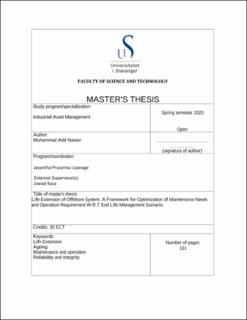| dc.description.abstract | In offshore production installations, numerous platforms, facilities, systems, and equipment’s are approaching or already exceeded their original design life. The industrial product is design for limited timespan and concluded by the phenomenon of decommissioning. When the system approaches that limit, the dominate ageing aggregation affect the performance parameter of the system and resulting in reliability, integrity, safety, and commercial issues. The process of life extension mitigates the effects of ageing mechanism and extend the life or safety limits of the system. The LE process also reduces or diminish the inherit risk possessed by system during their original design life and makes sure the adoption of advance technologies and consideration of new standards and codes.
The current thesis explores the industrial practices for extending the life and safety limits of offshore facilities. The present methodology of the topic is to develop a framework that covers the current market dynamics, operational and maintenance needs of the system, mitigation measures for arising risk factors and technological development of mechanism that generate sustainability and assures financial viability. The approach is to recognize the major asset reliability, integrity, vulnerability, and process safety risks that require detail assessment and evaluation process, to ensure and permit the asset to be operated beyond its design life.
The framework is step forward to figure out some major life extension obstacles by systematic methodology that helps in streamlining the process and provides an improved foundation for pragmatic decision making through four different phases: 1) Detail assessment , history evaluation and decision supportive information collection; 2) Technical assessment and plan for optimization of maintenance needs and operational requirement of the system; 3) Quantifying the uncertainty and prioritizing the risk component or equipment inside of the system; 4) Financial and technical validation of propose model and predictive benchmarking. The developed structured framework provides immense resilience in accommodating a wide and vast spectrum of industry cases. | |
